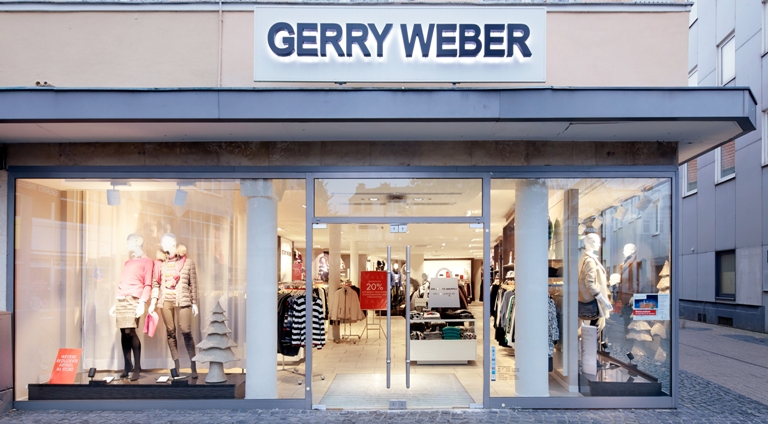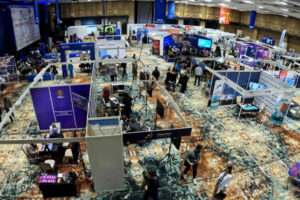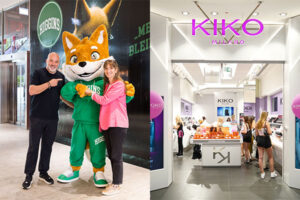After Zumtobel’s 2013 laboratory experiment on the unconscious effect of light in stores yielded very promising results, a field test has now clearly confirmed those results. In cooperation with the fashion company Gerry Weber, it assessed whether a target group-specific retail lighting solution actually positively influences the buying behavior of customers and therefore revenue. The initial target audience was that of the brand Gerry Weber and was analyzed on the basis of “limbic types” developed in the laboratory experiment.
FIELD TEST IN HERFORD
A sales area in Herford, North Rhine-Westphalia was the basis for a field test. Nothing was changed in the barely one-year-old Gerry Weber store except the lighting. Zumtobel used LED spotlights called harmonizers that it developed that were meant to appeal above all to the Gerry Weber target group. Harmonizers belong to the limbic type group “Balance,” members of which react particularly positively to moderate accent lighting. The new look of the retail space in Herford is thus characterized by a friendly and bright atmosphere and a warm color temperature of 3000 Kelvin.
Over a period of two months, the general purchasing behavior in the shop was observed before and after installation of the new lighting design. In addition, some customers were tested with a “Limbic Emotional Assessment” (LEA) process developed by the Nymphenburg Group, Zumtobel’s research partners. LEA empirically detects even the smallest, unconscious physical reactions, including brain waves and heart activity. Some customers were also asked explicitly about their impressions. Moreover, sales were compared with a reference store in the same test period. The result was clear: The adaptation of the lighting situation to the target group’s typical light preferences provided a sales increase of 10% as well as higher average sales per person in the specific target group when compared with the reference area over the same period.
When their emotions were measured implicitly, Gerry Weber’s customers responded positively to the newly installed Limbic Lighting concept when compared with the original lighting design. When questioned explicitly, the customers also expressed very positive opinions about the atmosphere created by the new Limbic Lighting concept.
A Gerry Weber store acted as a reference for comparison with the test branch in the same period. It was of comparable size, features, customer base demographics, and geographical location to the space in Herford. Even when compared with all Gerry Weber stores in Germany, the branch in Herford boasted above-average results.

ACTIVATION POTENTIAL FOR SALES INCENTIVES
The reactions measured by LEA showed an overall higher potential for the activation of customers’ purchasing impulses in Herford. This means that at a lower frequency and duration of stay, a higher level of interest in the sales area and the products was detected and the people tested were less stressed. The measurements also revealed that the customers felt at ease.
Martin Hörschläger, Head of Retail Operations at Gerry Weber, is delighted by the results: “For us as an international fashion brand, it was impressive to see what a strong influence lighting at the POS actually has on the basis of clear, scientific evidence. The collaboration with Zumtobel was a great addition and ultimately the key to better understanding the importance of our target group’s lighting preferences and to implementing those preferences. We have determined how profitable the Limbic Lighting concept was in our branch in Herford; we were able to record a significant increase in store sales on the sales area equipped with Limbic Lighting during the whole period. Compared with a reference area, the store optimized with Limbic Lighting achieved a better result by up to 10% in terms of sales and average purchase volume per customer over the same period.”
Ralf Knorrenschild, Senior Vice President Global Key Account Management Zumtobel, also reported: “The positive results of the field study confirm our view that light has the greatest potential to increase sales at the POS and has been underestimated for far too long in this function. With Limbic Lighting, we managed to develop a new way to spark customers’ interest in buying for our clients.”

THE LABORATORY EXPERIMENT
Recent research in the field of neuroscience has shown that purchasing decisions at the POS are made unconsciously more than 80% of the time and are therefore dependent mainly on emotional influences. The effect of lighting in stores has only been evaluated with varying survey methods, however, without taking into consideration the decisive aspect of the unconscious mind. For this reason, Zumtobel Research initiated a laboratory experiment in collaboration with the Nymphenburg Group to measure empirically the emotional effect of light on customers based on physiological responses.
The researchers used the “Limbic Model” developed by the Nymphenburg Group for the laboratory experiment. It focuses on consumers’ complex emotional personality structures. With the help of a questionnaire, the subjects were divided into seven different personality types – the so-called “Limbic Types.” These include “Open,” “Hedonists,” “Adventurers,“ “Performers,” “Disciplined,” “Traditionalists,” and “Harmonizers.” The aim of the research project was to gain knowledge about how these seven groups respond to different lighting scenarios at the POS. To this end, a new method developed by the Nymphenburg Group was applied: the (LEA). This can measure even the slightest physical reactions. In laboratory experiments, participants viewed 20 different lighting scenarios in a row with varying background and accent lighting, color temperatures, levels of contrast, and amounts of light. During this, their unconscious bodily reactions, including brain waves and heart activity, were recorded empirically. Based on these psychophysiological values, clear statements could be made about which parameters in the light scenarios triggered positive or negative emotions, or energized or relaxed, people in the specific target groups.
The results obtained showed that each target group can be optimally addressed. It also turned out that there is no light scenario that affects all “Limbic Types” equally positively. There were, however, individual lighting profiles that responded well to several types. Three major groups could thus be identified that demanded similar lighting solutions: The first group, Balance (Harmonizers, Traditionalists, and Open), responded particularly positively to moderate accent lighting. The second group, Stimulance (Hedonists and Adventurers), showed the best responses to light scenarios with stronger contrasts produced by accent lighting and a mixture of different spots. The third group, Dominance (Performers and Disciplined), was sensitive to unbalanced lighting concepts and is best positively stimulated with balanced, moderate effects. On the other hand, extremely high-contrast, narrow-beam lighting causes negative emotions in this group.
THE RESEARCH METHOD
The research method Limbic Emotional Assessment (LEA) was developed by the Nymphenburg Group and is based on methods from neuroscience and psychophysiology. The latter discipline is concerned with the relationships between processes in the brain and concomitant bodily reactions. Because of its link with Limbic, a field-proven brand and target group navigation model, LEA makes possible the recognition of specific target groups. The scientifically proven method LEA combines five different parameters that capture even the smallest physical reactions. Customers’ brain waves, skin conductivity, cardiac activity, and other physical reactions were measured to draw conclusions about their emotional state.
#LimbicLighting on the ‘net: www.lightlive.com/limbiclighting
THE NYMPHENBURG GROUP
For over 40 years, the consulting and market research company Nymphenburg Group has assisted leading international branded consumer goods manufacturers and retailers on topics from brand positioning to POS implementation. The basis for its consulting work is its extensive knowledge of consumer and shopper behavior. The Nymphenburg Group is one of the world’s leading specialists in neuromarketing. The company also specializes in the psychological POS and shopper research.
THE GERRY WEBER GROUP
Gerry Weber International AG, headquartered in Halle, Westphalia, Germany, is a global company that unites four strong brand families under one roof: Gerry Weber, Taifun, Samoon by Gerry Weber, and Hallhuber. Since its founding in 1973, Gerry Weber International AG has developed into one of the most famous fashion and lifestyle companies in the world, with almost 1,000 company-operated stores and sales areas worldwide, over 2,800 shop spaces, 281 franchise stores, and branded online stores in nine countries. With approximately 6,900 employees worldwide, the Group is moving rapidly along its path to being a global player.





